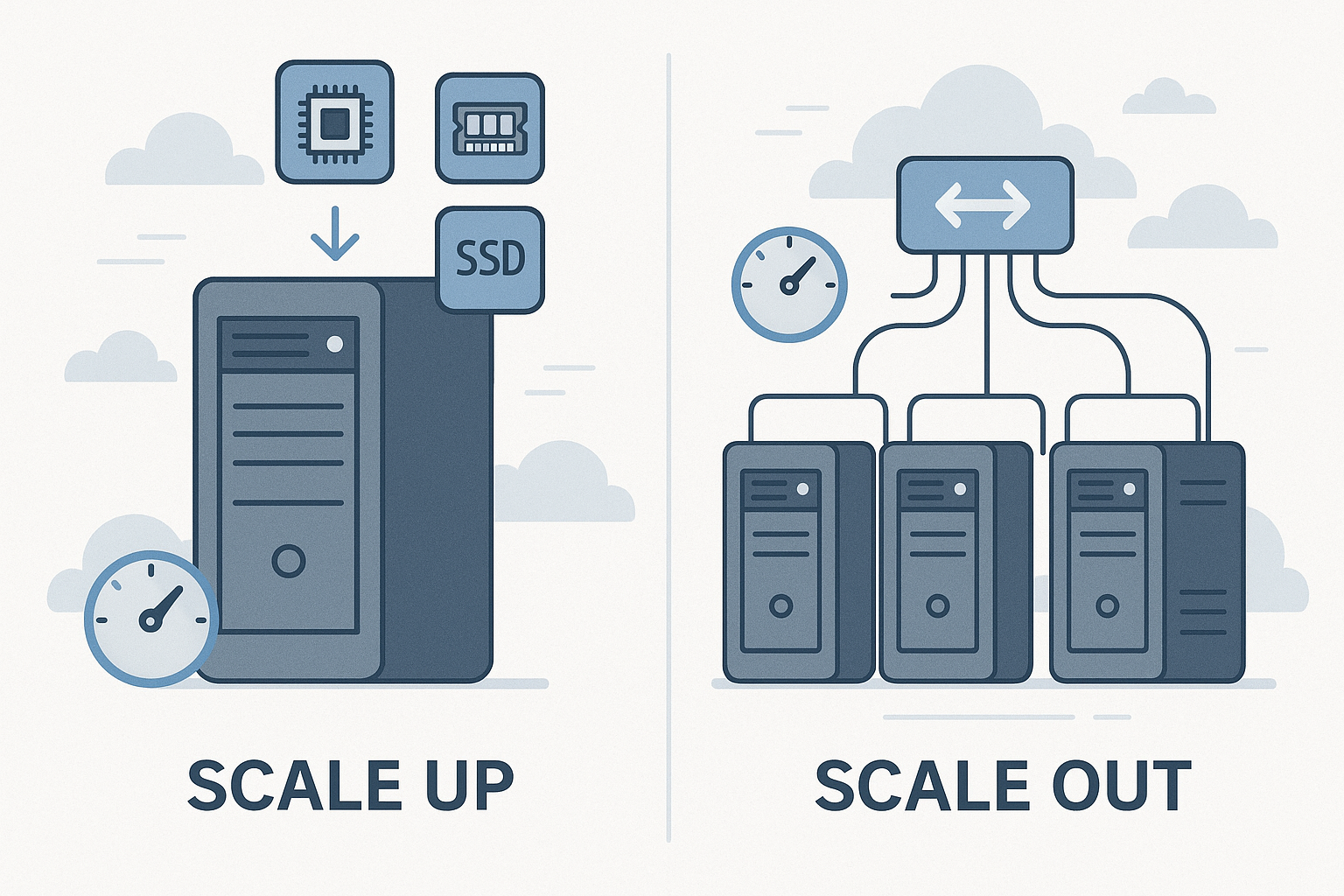System Scalability Strategies: Horizontal vs. Vertical Scaling
Published: 2025-05-20
System Scalability Strategies: Horizontal vs. Vertical Scaling
What is Scalability?
Scalability is a system's ability to handle increasing load—whether in the form of more users, transactions, or data—without performance degradation. There are two fundamental approaches to scaling: vertical and horizontal. Each has its advantages, disadvantages, and specific use cases.
Vertical Scaling
Vertical scaling, also known as "scaling up," involves increasing the computing power of a single system instance.
How Does It Work?
Imagine your application runs on a single server. When you notice performance decline due to increased traffic, you add more resources to that server:
- More RAM
- More powerful processor (or more cores)
- Faster disks (e.g., replacing HDDs with SSDs)
- Higher network bandwidth
In cloud environments like AWS, this means changing your EC2 instance type from smaller to larger—for example, from t3.medium to t3.large or even to m5.2xlarge.
Advantages of Vertical Scaling:
- Simple implementation – doesn't require changing the application architecture; you simply increase server power.
- Lower operational complexity – you still manage the same number of servers.
- Lower network overhead – data doesn't need to be transferred between multiple servers.
- Easier application state management – everything happens on one machine.
Disadvantages of Vertical Scaling:
- Hardware limitations – there's an upper limit to the power you can get from a single machine.
- Higher cost at large scale – the largest server instances are disproportionately expensive.
- No fault tolerance – if your single, powerful server fails, the entire application stops working.
- Downtime during upgrades – increasing server parameters often requires a restart.
Horizontal Scaling
Horizontal scaling, also known as "scaling out," involves increasing the number of system instances rather than their individual power.
How Does It Work?
Instead of increasing the power of a single server, you add more servers and distribute the load among them:
- Create multiple application instances
- Use a load balancer to evenly distribute traffic
- Implement state synchronization mechanisms between instances
In AWS, this means maintaining multiple EC2 instances of the same type (e.g., 10 t3.medium instances) instead of one large instance (e.g., m5.4xlarge).
Advantages of Horizontal Scaling:
- Virtually unlimited scalability – you can add more servers as needed.
- Higher availability and fault tolerance – even if one server fails, the others continue to handle traffic.
- Cost-effectiveness – multiple smaller instances are often cheaper than one large one.
- Geographic scalability – instances can be distributed across different regions, reducing latency for users in various locations.
Disadvantages of Horizontal Scaling:
- Greater architectural complexity – requires designing applications for multi-instance cooperation.
- State synchronization challenges – data and user sessions must be accessible to all instances.
- Operational complexity – managing a fleet of servers requires additional tools and processes.
- Need for additional components – load balancers, cache systems, distributed databases.
When to Use Each Approach?
Vertical Scaling Works Well When:
- Your application isn't designed to run on multiple instances
- You need a quick, temporary solution to a performance issue
- You have applications requiring large amounts of memory or computing power on a single node
Horizontal Scaling Works Well When:
- You expect significant and irregular traffic growth
- You require high availability and fault tolerance
- Your application has a modular architecture
- You can invest in appropriate infrastructure and DevOps tools
Hybrid Approach
In practice, most modern systems use a hybrid approach. This means employing both horizontal scaling (multiple instances) and vertical scaling (properly selected parameters for each instance based on its role).
For example:
- Application servers can be scaled horizontally (many smaller instances)
- Databases can be scaled vertically (fewer but larger instances)
- Cache layers can be scaled using a hybrid approach (a cluster of medium-sized instances)
Impact of Microservices Architecture
Microservices architecture works perfectly with horizontal scaling. By dividing an application into independent, small services, you can:
- Scale each component independently of others
- Optimize instance parameters for specific tasks
- More easily identify and remove bottlenecks
For example, in AWS, services such as Elastic Container Service (ECS) or Elastic Kubernetes Service (EKS) make it easier to deploy and manage microservices architecture.
